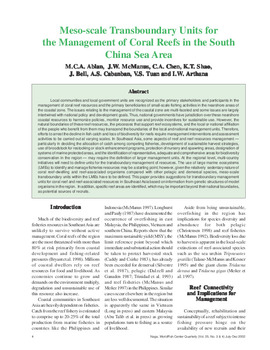Meso-scale transboundary units for the management of coral reefs in the South China Sea area

Citation
Ablan, M.C.A. et al. (2002). Meso-scale transboundary units for the management of coral reefs in the South China Sea area. Naga 25(3/4): 4-9
Local communities and local government units are recognized as the primary stakeholders and participants in the management of coral reef resources and the primary beneficiaries of small-scale fishing activities in the nearshore areas of the coastal zone. The issues relating to the management of the coastal zone are multi-faceted and some issues are largely intertwined with national policy and development goals. Thus, national governments have jurisdiction over these nearshore coastal resources to harmonize policies, monitor resource use and provide incentives for sustainable use. However, the natural boundaries of these reef resources, the processes that support reef ecosystems, and the local or national affiliation of the people who benefit from them may transcend the boundaries of the local and national management units. Therefore, efforts to arrest the decline in fish catch and loss of biodiversity for reefs require management interventions and assessment activities to be carried out at varying scales. In Southeast Asia, some aspects of reef and reef resources management — particularly in deciding the allocation of catch among competing fisheries, development of sustainable harvest strategies, use of broodstock for restocking or stock enhancement programs, protection of nursery and spawning areas, designation of systems of marine protected areas, and the identification of representative, adequate and comprehensive areas for biodiversity conservation in the region — may require the definition of larger management units. At the regional level, multi-country initiatives will need to define units for the transboundary management of resources. The use of large marine ecosystems (LMEs) to identify and manage fisheries resources may be a starting point; however, given the relatively sedentary nature of coral reef-dwelling and reef-associated organisms compared with other pelagic and demersal species, meso-scale transboundary units within the LMEs have to be defined. This paper provides suggestions for transboundary management units for coral reef and reef-associated resources in Southeast Asia based on information from genetic structures of model organisms in the region. In addition, specific reef areas are identified, which may be important beyond their national boundaries, as potential sources of recruits.
Permalink
Date Available
Type
Publisher
Countries
Copyright
CC BY 4.0
Research Themes
Language